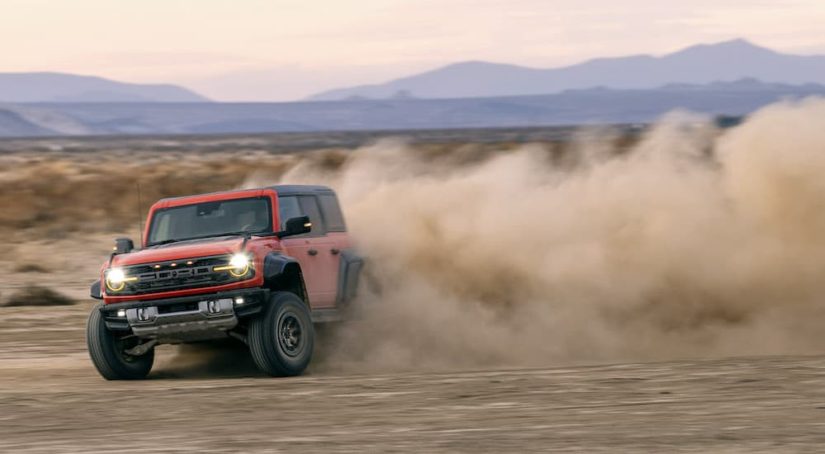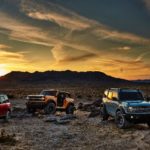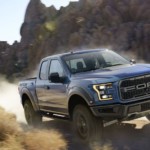In this corner, standing tall on 12 inches of ground clearance, holding 450 horsepower and 510 lb-ft of torque under the hood, is the impressive, incomparable Ford F-150 Raptor! But here comes the challenger. Throw away your history books, kids, because this has never happened before. With a ground clearance of 13.1 inches, a track width of 73.6 inches, and the mighty growl of 400 horsepower, here comes the Ford Bronco Raptor! This is RaptorMania–Ford dealership style.
You can practically hear the crowd and engines roaring and revving. Exhaust fills the air, not entirely overtaking the scent of popcorn and other fairground foods. The excitement is palpable, but hold on–just relax–this is only a hypothetical situation. However, should the Bronco Raptor and F-150 Raptor face off in person, the fervor will undoubtedly be the same as when WWE Champion Hulk Hogan and Mr. T paired off against “Rowdy” Roddy Piper and Paul “Mr. Wonderful” Orndorff in the very first WrestleMania.
But why? What’s the deal with our deep, visceral appreciation of Ford’s latest off-road beasts? Drivers who have conquered obstacles no more dangerous than a gravel parking lot in the past 30 years are experiencing an impulsive call to the trail, and suddenly, being outside is cool again. Let’s take a look at what makes the Raptor family so darn epic and why everyone wants one.
The Nostalgia Factor
When Ford released the latest version of the Bronco in 2021, drivers were hit with a wave of blatant nostalgia. The new Bronco reminds many people of the classic, third-generation Bronco produced from 1980 to 1986. There are plenty of differences, of course, but the similarities in shape and appearance are notable.
There’s a little Bronco nostalgia for drivers of all ages. The G.O.A.T. vehicle–that’s “Goes Over Any Type of Terrain” for any first-timers–was introduced in 1966 and disappeared from production in 1996 when it was replaced by the Expedition. Don’t get mad at the Expedition, though, as that was exactly the type of SUV people wanted in the late 1990s.
For 13 years, that left drivers with several worthy off-road options and one really big “but.” You could buy an off-road-ready truck or SUV from several manufacturers, BUT you had to do a lot of the customization and outfitting yourself. Suspension lifts, axle ratios, bash plates, and differentials were all something the driver had to tweak on their own to get a true crawling, fording, climbing, Baja-ing, hooning beast. And, admittedly, sometimes those vehicles pushed the boundaries of what was street legal.
Then came the first F-150 Raptor iteration in 2009. As part of the SVT or Special Vehicles Team, the F-150 SVT Raptor R made headlines when it competed in the Baja 1000 using stock parts. Ford proudly admitted that the SVT Raptor R was a way of testing off-road parts and capability for the F-150 lineup. It goes without saying that this new, more aggressive version of the Raptor was a hit. And why not? After all, Ford gave drivers exactly what they craved.
The Freedom to Explore
It’s only natural that the words “Bronco Raptor” and “F-150 Raptor” bring to mind a sense of nostalgia. Even several generations ago, these vehicles brought with them a sense of freedom and adventure. Depending on your age now, it is entirely possible that your grandparents or great-grandparents were crawling across uncharted territory in one of the earliest versions of the Bronco. And while we like to think that 2009 was just a couple of years ago, it’s actually been over a decade.
Without a doubt, many things have changed, but the human need for adventure, excitement, and freedom is not one of them. In fact, the growing pressures of balancing an adequate work-play-life model, along with pandemic-related lockdowns, may have shifted our recreational tastes from spending a quiet night on the sofa to heading out to the trails to work out some feelings. Therefore, purpose-driven off-road vehicles like the Bronco Raptor and F-150 Raptor serve critical roles in our lives: to remind us to get out and enjoy the world.
The Bronco Raptor was specifically designed for Ultra4 Racing needs. It packs a 3.0L twin-turbo EcoBoost engine and a HOSS 4.0 suspension system with FOX 3.1-inch Internal Bypass Semi-Active dampers. The vehicle is surrounded by suspension sensors that gauge terrain conditions by the millisecond to provide the correct torque to each wheel. It has seven total G.O.A.T. Modes that allow it to tackle everything from tightly winding trails to desert runs.
The F-150 Raptor is no slouch, either. It comes equipped with a 24-valve 3.5L twin-turbo EcoBoost engine, enormous FOX Live Valve internal bypass shocks, and its own set of terrain management modes, including Slippery, Baja, and Rock-Crawl. And since it’s a truck, it gets to do truck things like tow up to 8,200 pounds and stow up to 1,400 pounds of stuff in its bed. It has a 5-link rear suspension with 24-inch coil springs and a Panhard rod to handle these loads with ease.
When taken off-road, it is clear that this is what both the Bronco and F-150 Raptor are meant to do. This is where they belong. And so do you.
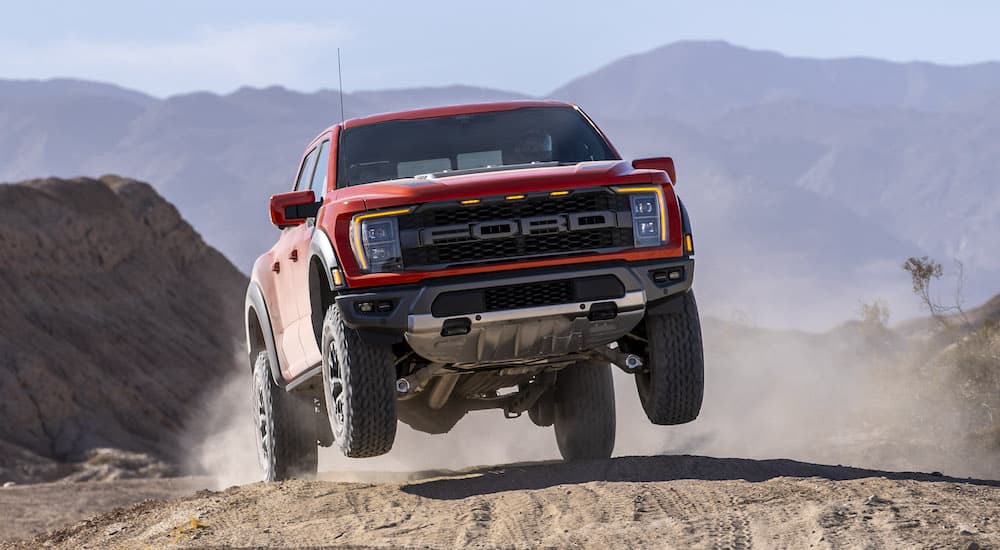
The Responsibility Factor
Nostalgia and freedom are all well and good, but what about being a responsible adult who gets work done and pays the bills? Even WrestleMania gives back to the community. So, how do you mix the business of being an adult with the pleasure that comes from off-roading?
First and foremost, both the Bronco Raptor and F-150 Raptor are street legal. Ford is aware that most drivers can’t purchase a vehicle to match every mood, which is why the Raptor family is equally practical on the road and the trail. In addition, both are capable workhorses and can tow impressive loads. The Bronco Raptor has a towing capacity of 4,500 pounds, while other Broncos top out at 3,500 pounds. The F-150 Raptor can tow up to 14,000 pounds and can be outfitted with Ford’s Tow Technology Package that adds helpful trailer features such as reverse guidance, backup assistance, and a 360-degree exterior camera to keep eyes on the load.
If what’s in the cabin is as important to you as performance, the Bronco Raptor and F-150 Raptor do not disappoint. The seating keeps passengers secure and comfortable even when things get rocky. Ford’s SYNC 4 system is on board both Raptors with a 12-inch touchscreen that gives you access to essential details and enhanced voice recognition that keeps your hands on the wheel and your focus ahead.
Oh yeah, and you can take the doors and roof off the Bronco and enjoy the fresh air. Is that the pinnacle of adult responsibility? Maybe not, but it’s awfully enjoyable.
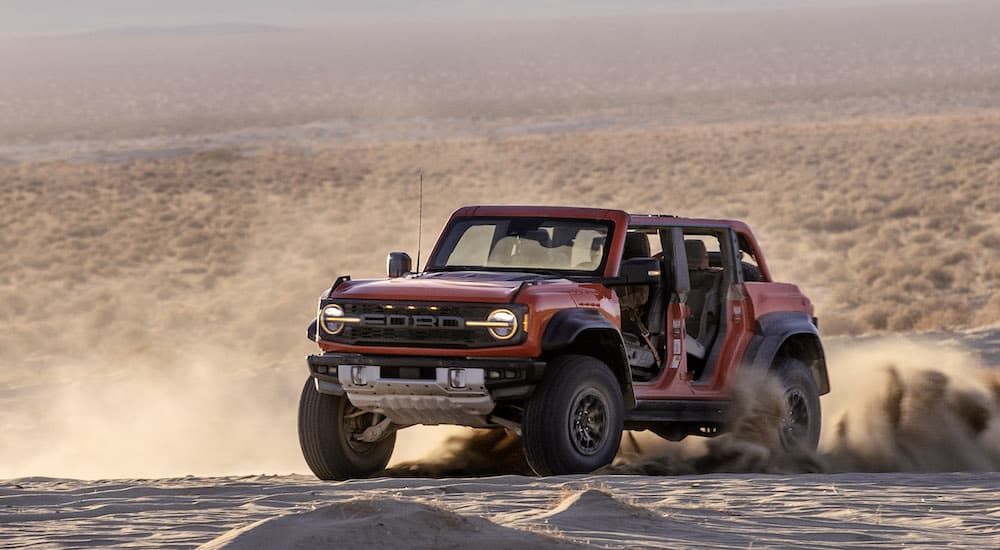
Who Wins RaptorMania?
If the Bronco Raptor and the F-150 Raptor were to face off, in full nostalgic WrestleMania style, the winner would obviously be the Raptor. All joking aside, these are both highly capable vehicles that have been carefully designed for a specific purpose: to be absolute beasts. The driving public hasn’t seen anything quite like this in several years, so the introduction of the Raptor family is bound to evoke a variety of emotions and thoughts. Whether you miss the fun you had on the trails in the 1980s or recall the first time you realized you could go mud-running in a pickup truck, off-roading and mud culture hit differently when manufacturers start celebrating the lifestyle.
Does this mean everyone is going to be off-roading now? Probably not. There are still plenty of drivers who are very comfortable in their sedans and coupes. It just means that those of us who do like to hit the mud will do so in style.
